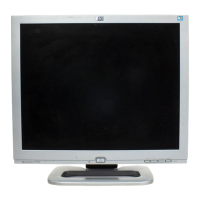
Do you have a question about the HP 1332A and is the answer not in the manual?
Product title and primary subject of the manual.
Applies to instruments with specific serial prefixes.
Essential safety requirement for operation.
Critical safety warning for environment.
Critical safety warning about internal voltages.
Safety procedure for service personnel.
Specific safety for CRT.
Safety warning against unauthorized changes.
General warning for procedures.
Describes manual content and instrument purpose.
Lists critical instrument specifications and general information.
Lists optional accessories available for the instrument.
Describes factory-installed modifications and field options.
Explains how to identify the instrument and manual.
Details safety features like implosion protection and X-ray emission levels.
Describes interface connectors and front panel controls.
Details power requirements and operating conditions.
Provides information for instrument installation.
Guides on inspecting the instrument upon receipt for damage.
Details operating power needs and cable connections.
Instructions for returning the instrument for service or repair.
Provides instructions for operating the 1332A display.
Illustrates and describes front panel controls and rear connectors.
Steps to prepare the instrument for operation.
Describes functional descriptions keyed to block diagram.
Explains the function of various circuits.
Details the low-voltage power supply circuitry and operation.
Details the high-voltage power supply circuitry and operation.
Explains the X and Y axis deflection amplifier circuits.
Explains the Z-axis amplifier circuit.
Introduces performance checks and adjustment procedures.
Lists equipment required for checks and adjustments.
Outlines procedures to verify instrument specifications.
Describes the procedure to check X and Y amplifier rise time.
Describes checks for X and Y amplifier deflection factor.
Describes the procedure to check CRT beam settling time.
Checks beam deflection polarity for positive/negative inputs.
Checks if zero input can be set off-screen.
Measures input resistance of X, Y, and Z amplifiers.
Checks input capacitance of X, Y, and Z amplifiers.
Checks if deflection range exceeds full screen.
Checks crosstalk between deflection amplifiers.
Checks Z-axis polarity and gain characteristics.
Checks Z-axis amplifier rise time.
Checks linearity of displayed pulses.
Checks trace deviation from vertical/horizontal.
Checks Common Mode Rejection Ratio for Option 106.
Checks TTL blanking function for Option 216.
Section covering instrument calibration and tuning procedures.
Procedure to check LVPS outputs.
Procedure to adjust the HVPS.
Procedure to adjust focus centering.
Procedure to adjust intensity limit.
Procedure to align trace and ensure orthogonality.
Procedure to adjust Z-axis high-frequency limit.
Procedure to adjust X and Y gain.
Procedure to adjust X and Y axis high frequency.
Introduces information for ordering replacement parts.
Provides details on how to order replacement parts.
Provides information to backdate the manual for specific instruments.
Lists changes required for different serial prefixes.
Details manual changes for serial prefixes.
Details manual changes for serial prefixes.
Details manual changes for serial prefixes.
Details manual changes for serial prefixes.
Contains schematics, repair, and troubleshooting information.
Schematics are printed for easy reference to circuit function.
Illustrates component locations on assemblies.
Outlines periodic checks and services for instrument upkeep.
Provides procedures for replacing assemblies and components.
Details the procedure for removing and installing the CRT.
Guides on identifying and replacing semiconductor devices.
Provides a systematic approach to diagnosing instrument faults.
Guides for diagnosing LVPS malfunctions.
Guides for diagnosing HVPS malfunctions.
Indicates DC voltages for active components on schematics.












